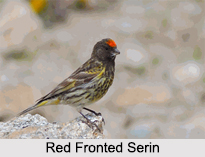 The Indian Subcontinent provides suitable habitats to various species of birds for residing and nesting. Serins are no exception in this regard. Tibetan Serin and Red Fronted Serin are the two serins which have been recorded in India. They belong to the kingdom, Animalia; phylum, Chordata; class, Aves; order, Passeriformes and family, Fringillidae. These serins are described below.
The Indian Subcontinent provides suitable habitats to various species of birds for residing and nesting. Serins are no exception in this regard. Tibetan Serin and Red Fronted Serin are the two serins which have been recorded in India. They belong to the kingdom, Animalia; phylum, Chordata; class, Aves; order, Passeriformes and family, Fringillidae. These serins are described below.
Tibetan Serin
The species name of Tibetan Serin is Spinus Thibetanus. On March, 2013, Tibetan Serin was traced in Hee Village near Varsey Rhododendron Sanctuary in Sikkim by a group of birders from West Bengal. Its natural habitat is temperate forests. The adult male bird has olive greenish upperparts and yellow underparts. The supercilium of the bird is yellow in appearance. The rump of the bird is yellowish green. Yellowish green color broadly separates wing and tail feather of this bird. T,he female counterpart can be described as a bird with paler yellowish colored throat. It has black flanked breast with streaking. There is black streaking present on the darker grayish green upperparts. As compared to the male bird, the female bird has more clearly defined wing-bars. It is important to note that all plumages of Tibetan Serin are devoid of yellow panels on wing. These birds usually breed in mixed forest. If the bird is duller green, has tinged brownish-buff colored upperparts, duller rump, buff fringes to greater coverts and has paler or heavily streaked underparts, it can then be identified as a juvenile.
Red Fronted Serin
The species of Red Fronted Serin is Serinus Pusillus. Red Fronted Serin has been traced in Ladakh and other parts of the Indian Himalayas and chooses high mountainous regions. The bird exhibits variance in plumage. The forehead of the bird is red in appearance. The foreparts are sooty in appearance. If the bird has buff brown colored head, it can then be identified as a juvenile. The adult Serins resemble very dark redpolls. The length of the bird ranges from 11 to 12 cm. This Serin depends on canary grass seed, millet and other small seeds for survival.



















